Reserve personnel 75,000 | Founded June 1964 | |
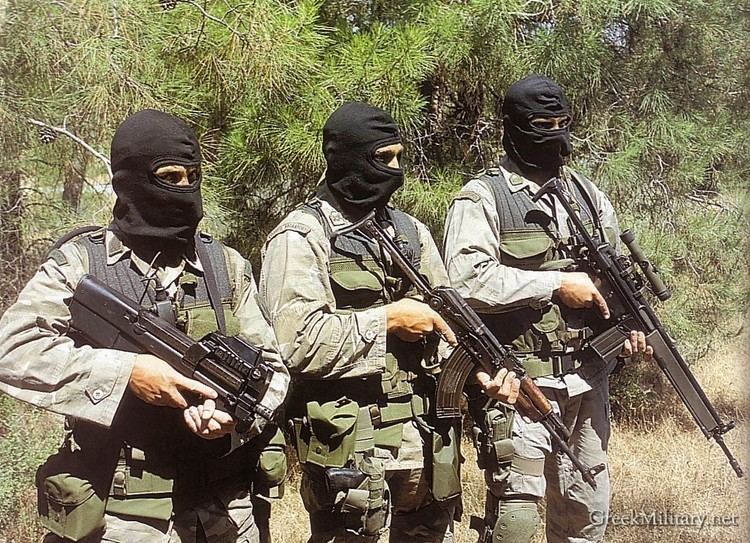 | ||
Commander-in-Chief Lieutenant General Georgios Mpasiakoulis Chief-of-Staff Brig. Gen. Georgios Karagiannis Similar Hellenic Force in Cyprus, Hellenic Armed Forces, Hellenic Ministry of National, Hellenic Army, Hellenic Navy | ||
Cypriot national guard
The Cypriot National Guard (Greek: Εθνική Φρουρά, Ethnikí Frourá), also known as the Greek Cypriot National Guard or simply as "National Guard", is the combined arms military force of the Republic of Cyprus. This force consists of Air, Land, Sea and Special Forces elements, and is highly integrated with its first and second line reserves, as well as supporting civilian agencies and paramilitary forces.
Contents
- Cypriot national guard
- Cypriot national guard and egyptian forces battle at larnaca airport cyprus 1978 bbc audio
- History
- Operational History
- Current organisation
- Early operational history 1963 1974
- Coup and invasion in 1974
- Post war revival 1974 2004
- Early Operational History 1963 1974
- Coup and Invasion in 1974
- Post War Revival 1974 2004
- European Union Member Statehood 2004 Present
- Army
- Navy
- Military Equipment Inventory
- References
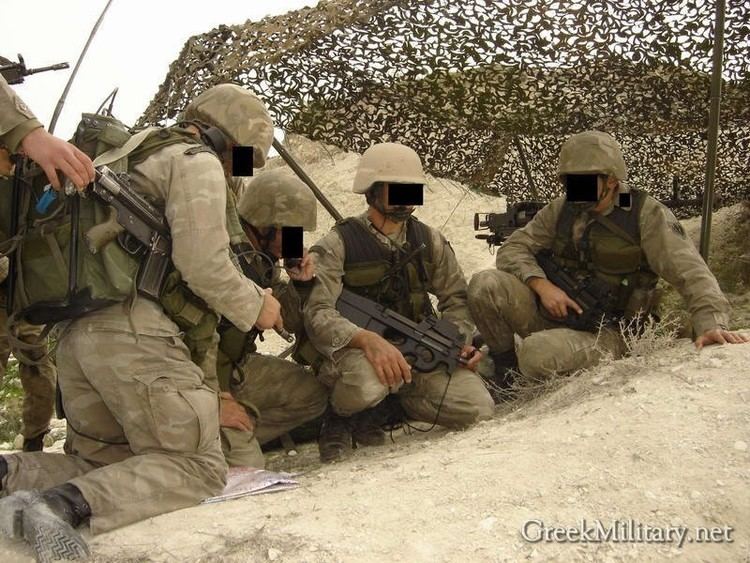
Greece currently maintains a garrison in the Republic of Cyprus under the designation ELDYK or Hellenic Force in Cyprus (Greek: Ελληνική Δύναμη Κύπρου, abbreviation: ΕΛΔΥΚ or ΕΛ.ΔΥ.Κ.), but this is not officially part of the Cyprus military and primarily serves as a NATO regimental-level influence for training and support of the National Guard.

Cypriot national guard and egyptian forces battle at larnaca airport cyprus 1978 bbc audio
History
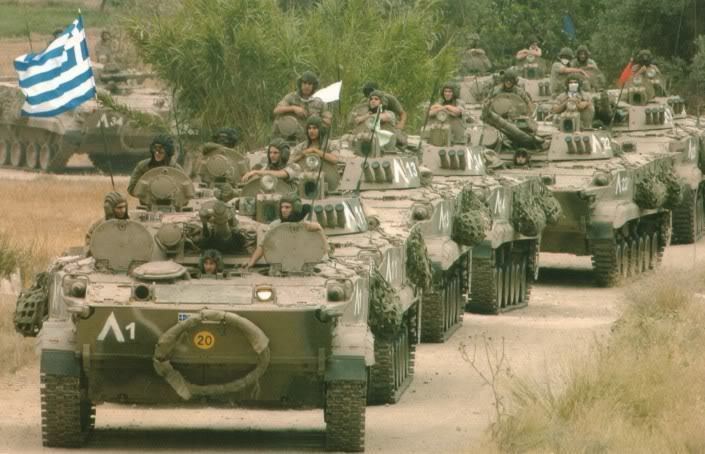
The National Guard was established in 1964 as a force composed predominantly of ethnic Greeks, following the 1963–1964 breakdown of social and political relations between Greek and Turkish Cypriots on the island of Cyprus. As outlined by the tripartite Treaty of Alliance (1960) and defined by the early Constitution of 1960–1963, Cyprus was entitled to an army of 2,000 men, to be made up of 60% Greek and 40% Turkish personnel. The first elected President of the Republic of Cyprus, Archbishop Makarios III, proposed thirteen constitutional amendments to the 1960 constitution, which would have adjusted distribution of manpower and voting power for all civil and military services. This adjustment was aimed at giving greater representation and influence to the Greek Cypriot majority, which at the time formed around 82% of the island's indigenous population.
Operational History
The Cypriot National Guard has been involved in multiple combat operations, all within Cyprus territory.
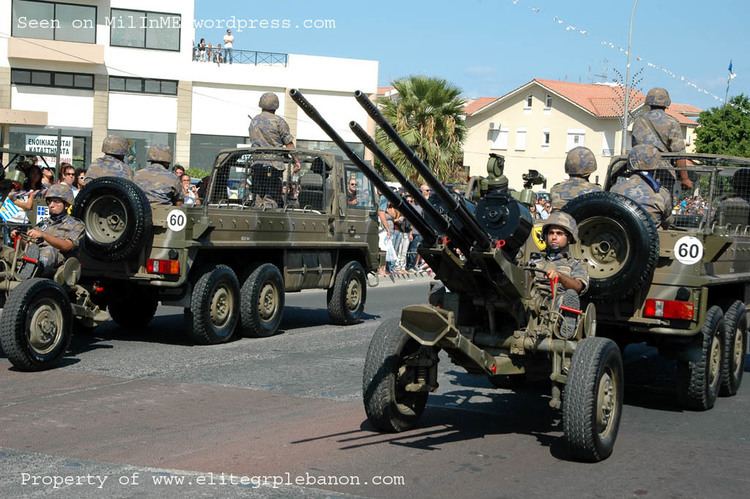
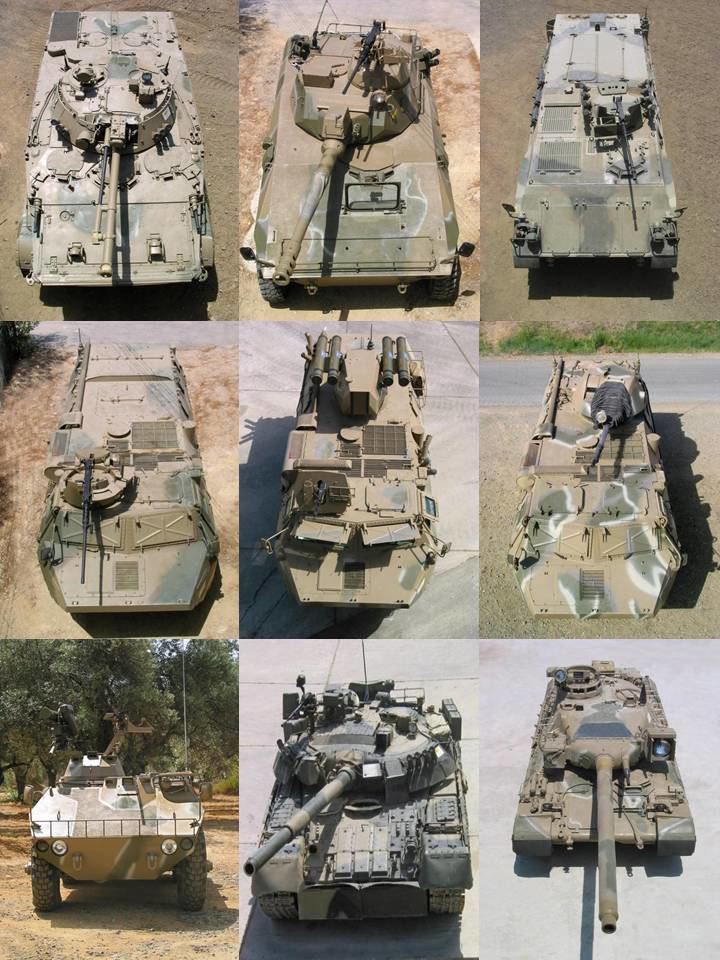
Currently, only Greek Cypriots serve in the military. Legally, the Greek Cypriot community comprises the ethnic Greek population as well as Cypriots belonging to three Christian minorities – the Armenians, Latin Rite Catholics and Maronites. Since 2008, service is mandatory for all members of the Greek Cypriot community and not only for ethnic Greeks. The current supreme commander is a Greek military commander, as have been all of his predecessors.

Military service in the Republic of Cyprus is mandatory for males (Efthymiou 2016). The obligatory service period is 14 months. All male visitors to the island of military age (16 and over) who have a father of Cypriot extraction are required to obtain an exit visa from a Defence Ministry office.
Current organisation

The main body of the Cypriot ground forces is made up by 2 infantry divisions, 3 infantry brigades, 1 armored brigade and 1 support brigade.
Early operational history (1963 - 1974)
The Cypriot National Guard, in its existent form, was initially mobilised circa mid-1963 as a Greek Cypriot infantry force with some small elements dedicated to artillery, anti-armour and light armour forces. This force inherited some mixed equipment from its pre-civil war organisation, including 54 British-made 25-pounder gun-howitzers, 40 Marmon-Herrington Armoured Car (Mk. IVF), 4 Shorland light armoured cars, 2 Daimler Dingo light armoured cars, 5 C-17 light armoured trucks and a variety of machine guns, mortars and a few anti-tank weapons (namely M20 Super Bazookas and a small number of PIAT weapons). The Greek Cypriots also possessed some Bofors 40mm anti-aircraft guns, along with a variety of Bedford trucks and old US made jeeps.
The military confrontation at Kokkina in August 1964 between Greek Cypriot and Turkish Cypriot forces saw the Greek-Cypriot force mobilised for the first time to attempt to eliminate a fortified coastal enclave in the Tylliria region of the island, in an effort to stop Turkish vessels putting ashore there to offload food, weapons and ammunition for the Turkish Cypriot militia units active in that region. The attempted siege of Kokkina began on 6 August and ended on 9 August after two days of daylight air strikes by the Turkish Air Force around Kokkina and neighbouring Kato Pyrgos (a mountain village overlooking Kokkina which was being used for observation and artillery fire-direction positions). Having sustained manpower and material losses as a result of these air strikes, the Cypriot National Guard pulled back slightly and solidified a perimeter of containment around Kokkina, leaving the Turkish Cypriot village isolated from the rest of the island, and buffered only a narrow UN demilitarized zone.

Aware of the glaring deficiency of their military capabilities, the leadership of the Cypriot National Guard under General George Grivas (an ultra-nationalist commanding officer largely subordinate to the Greek Junta in Athens) was able to compel the civilian Government of Cyprus, under Archbishop Makarios to seek out foreign assistance for a massive armament campaign. Since Cyprus could not afford major weapons purchases under her own depleted national budget, Makarios was forced to dispatch an envoy on 1 October 1964 to the Soviet Union to request military assistance. This move resulted in rapid Soviet assistance, widely regarded by Western countries as a step towards a Cold War alliance between Cyprus and Russia.
As soon as 23–24 December 1964, a Russian Navy freighter arrived at Limassol Port carrying the first batch of arms intended to re-equip the National Guard. These supplies included 4 unidentified armoured vehicles, and 130 ZIL heavy trucks, along with sufficient number of crates to fill 36 Bedford trucks. After this initial delivery, arms transfers made by the Russian Navy to Cyprus accelerated, with freighters travelling via Alexandria in Egypt to Limassol under cover of night. These deliveries included a full package of Soviet-made radars and radio systems to complement the structural and strategic requirements of a reinforced National Guard. In addition, a consignment of 32 Soviet-made T-34/85 medium tanks (from Yugoslav surplus) were delivered along with 40 BTR-152 armoured personnel carriers, as well as a batch of 30 M-1944 100mm light field howitzers, 40 modern 3M6 Shmel anti-tank missile firing units, a batch of ZPU-1 14.5mm anti-aircraft guns and a consignment of around 4500 Czech surplus AK-47s, as well as machine guns and mortars.
After 1965, and until 1974, the civilian Government of Archbishop Makarios became increasingly alienated by the relationship between the National Guard leadership and the ruling military Government of Greece. Few funds were made available to secure other armaments of technical support, and the National Guard was forced to develop alternative means to armament and self-sustainment. A Technical Corps was established to produce and retrofit a series of improvised armoured vehicles from unneeded ATS-712 Soviet tractors, resulting in 10 locally produced "TS" armoured personnel carriers. A lack of spare parts meant that by the time of the 1974 military coup against Archbishop Makarios, the National Guard was experiencing severe technical difficulties with its T-34 tanks. The problem for the National Guard was further compounded by the refusal of Makarios' loyalist paramilitary force to hand over some 4500 Czech automatic rifles and a variety of other weapons which had been kept at a warehouse near Nicosia Airport, and which were handed over to the UN in January 1972.
Coup and invasion in 1974
On 15 July 1974, the Cypriot National Guard, under its own leadership and in conjunction with the EOKA-B ultra-nationalist organisation, overthrew the civilian Government of Archbishop Makarios in Nicosia and attempted to assassinate him by using tanks and infantry to storm the Presidential Palace. Makarios escaped, but the confrontation in Nicosia resulted in multiple casualties as the National Guard units engaged in a gunfight with Makarios' loyalist forces. Since Kyrenia in the north of the island was not expected to present much armed resistance to the coup, many forces which were stationed there to fend off a threatened Turkish invasion were sent to Nicosia on 15 and 16 July to enforce the coup in the Capital. Kyrenia was thus, poorly defended when the Turkish invasion began on 20 July.
On 20 July 1974, Turkey commenced an air and sea invasion of northern Cyprus, under the codename "Attila-1" which had the anticipated aim of seizing Kyrenia as a beachhead with amphibious forces, whilst simultaneously establishing a beachhead from Kyrenia to the northern suburbs of Nicosia (the site of two Turkish fortified enclaves that could be used as strongholds to seize northern Nicosia) using parachute forces. The attack was heavily supported by a daylight air campaign, allowing Cypriot A/A flak to be suppressed to the extent that Turkish transport planes could drop parachute forces north of Nicosia in broad daylight from 20 July to 23 July. In disarray, the Greek Cypriot military leadership enacted the "Aphrodite-2" defence plan to coordinate a containment and resistance to the invasion forces. This plan, however, proved to be ineffective in either containing or repelling the Turkish forces already ashore. At the same time, the Greek Cypriot EOKA-B forces, subordinate to their own de facto leadership, enacted their own interpretation of the existing Aphrodite defence plan (sometimes referred to historically as Aphrodite-3 or Hephaestus) and attacked multiple Turkish Cypriot enclaves simultaneously, causing heavy Turkish Cypriot non-combatant casualties and rounding up an estimated 20,000 Turkish Cypriot POWs who were interred at Limassol until later that year.
Post-war revival (1974 - 2004)
Immediately following the 1974 conflict, the Cypriot National Guard experienced a major depletion of its military capability due to lack of equipment and ammunition, compounded by the wartime economic collapse of the country. A small armored unit of 11 surviving T-34/85 tanks continued to operate in service until circa 1985, albeit in poor mechanical condition with lack of spare parts. Small numbers of other armored vehicles (including re-engined Marmon Herrington Mk-IV F armored cars) and artillery guns from the pre-war period also continued in service until the economic revival of the Cyprus Republic in the mid-1980s.
In the early 1980s, Cyprus sought new suppliers of arms in order to circumvent US and European embargoes, combined with an apparent unwillingness by the Soviet Union to supply further aid. From Brazil, a large consignment of new light armored vehicles was ordered in 1982, 15 EE-3 Jararaca armored reconnaissance vehicles (delivered 1984-1985), and 126 EE-9 Cascavel armored fighting vehicles (delivered 1984-1988).
Faced with an urgent need for infantry-portable air-defense equipment, the Cypriot Government was able to procure 20 firing units of Strela-2/ SA-7B Grail anti-aircraft missiles along with 324 live rounds from neighboring Syria in 1984.
Major arms orders were also placed with France, one of the few European powers still willing to support weapon deliveries to Cyprus. In 1984, Cyprus purchased from France a total of 27 VAB-VCI infantry fighting vehicles with 20mm cannon (delivered 1985-1988) along with 100 VAB-VTT armored personnel carriers (delivered 1985-1988).
In 1987, the first batch of new French tanks were purchased to replace the T-34s that had been removed from service - a total of 15 AMX-30B2 main battle tanks and 1 AMX-30D recovery vehicle, all delivered the following year. Also in 1987, Cyprus purchased from France a unit of 6 SA-342L Gazelle scout anti-tank helicopters and 18 VAB-VCAC guided-missile tank-destroyers, along with 1200 HOT-2 anti-tank missiles (interchangeable for both airborne and ground launcher platforms), all delivered in 1988. A further 2 VAB-VTT armored personnel carriers were ordered as options in 1987 (delivered in 1988) along with 250 MILAN-2 anti-tank missile rounds and an unknown number of firing units (possibly 45).
In 1989, the Cyprus Government ordered a batch of 35 AMX-30B2 main battle tanks and 1 AMX-30D armored recovery vehicle as part of a $115 million US dollar purchase from France. The deal included 12 GIAT Mk F-3 self-propelled 155mm howitzers and 12 AMX-VCI armored personnel carriers. All of the equipment ordered from France in this year was delivered from 1990-1991.
In 1990, Greece supplied Cyprus with 81 ELVO Leonidas-2 (4K-7FA) armored personnel carriers, which were fielded to provide the Greek ELDYK Army Regiment in Cyprus with a Mechanized Infantry vehicle force. These were followed in 1996-1998 by a batch of 52 French-made AMX-30B main battle tanks supplied from Hellenic Army surplus, along with a further 65 new Leonidas-2 armored personnel carriers delivered in 1996-1997.
Early Operational History (1963 - 1974)
The Cyprus Naval Command became active circa 1963, following the outbreak of civil conflict between extremists within the Greek and Turkish ethnic communities of the island. At the outset of operational status, the Cyprus Naval Command was manned by Greek Navy officers and junior officers, whilst the sailors were primarily Greek Cypriot conscripts of educated backgrounds. The first equipment made available to the Cyprus Naval Command was a set of three ex-German WW2-era R-boats (two of the R-151 class called P-01 Arion and P-02 Phaethon, and one of the R-218 class under the name Dedalos). All three vessels were in service by August 1964, having been purchased from a shipyard in Piraeus, Greece by a private sponsor named A. Leventis. The three vessels were in poor condition due to their age, and had to be refurbished in Greece before delivery to Cyprus.
On 6 August 1964, the Cypriot National Guard was mobilised to intervene in the ongoing inter-ethnic confrontation at Kokkina, a Turkish-Cypriot controlled fortified enclave on the south-western edge of Morphou Bay in the north-west of the island. By this stage, the Cypriot National Guard was effectively a Greek Cypriot security force, which by virtue of its commander, General George Grivas, was subordinate to Athens (in Greece) and not to Nicosia (in Cyprus).
Kokkina was regarded by Grivas as a major coastal beachhead for Turkey to land weapons in Cyprus, with the aim of arming the Turkish Cypriots. For this reason, he persuaded the military government in Athens to authorise an all-out assault on Kokkina, with the aim of eliminating the beachhead, and preventing more weapons being delivered to Turkish Cypriot militia groups.
As a necessity of mounting such an assault, Grivas required a naval presence off the coast of Kokkina, in order to bombard the enclave from the sea, and to prevent any other shipping from interfering. Consequently, the Phaethon and the Arion were utilised in the assault and commenced their assault with broadsides of 40mm and 20mm gunfire into the enclave on 6 August. This action was coordinated with battery fire from six land-based 25-pounder guns and around a dozen mortars used by ground forces to besiege the enclave from the south and south-west.
The siege continued until 8 August, when the Turkish Government opted to intervene with air strikes, as it became clear to all parties that Kokkina's defences were likely to collapse, regardless of a UN presence in the area. The Turkish Air Force dispatched a number of formations of F-100 Super Sabres to commence air strikes against the Cypriot ground and naval forces, in broad daylight and flying at low level.
The first formation of F-100 Super Sabres spotted the Phaethon near to a small fisheries harbour west of Kokkina. The Phaethon commenced evasive manoeuvres and put up 20mm cannon fire, but was struck in the engines by strafing rockets and exploded into flames, killing seven of her crew. One of the four survivors then piloted the ship with a single functioning engine to run aground next to the harbour, so that the crew could be recovered by local fishermen. The Phaethon was then gutted by flames, rendering it a wreck.
Minutes after the attack on the Phaethon, a second formation of F-100s spotted the Cypriot gunboat Arion further up the coast towards Kokkina. The Arion was strafed with guns and rockets, causing superficial damage. As the Arion successfully made her escape using evasive manoeuvres, an F-100C Super Sabre, piloted by Cpt. Cengiz Topel of 112 Filo was shot down by a Cypriot 40mm anti-aircraft gun emplacement on the shoreline.
The loss of the Phaethon was a severe shock to the National Guard leadership, and was compounded by further casualties and material losses at Kato Pyrgos, a nearby Greek Cypriot village which was bombarded on 8 and 9 August in an effort to dislodge National Guardsmen using its hilltops for directing artillery fire with radios.
A scramble for arms featured prominently throughout 1964, as the Cypriot National Guard compelled the civilian Government to solicit Soviet support. In early 1964, the Greek Cypriots acquired a large package of radars, communications and logistical support apparatus for SA-2F Guideline surface-air missiles, and only a NATO blockade of Limassol in 1965 prevented the live missile rounds and their TELs from being delivered. With no effective air-defence measure in place, the Greek Cypriots utilised the radars at one western and one eastern coastal mountain points in the Petedaktylos Mountains stretching across the north of the island. These radars provided both air and surface tracking capability for aircraft and shipping.
In late 1964, it was reported that Greek Cypriot Naval crews had been sent to Egypt to train on Soviet Komar class fast attack craft. Western media sources assumed that Cyprus was being prepared to receive Komar class vessels, although Cyprus eventually chose cheaper naval vessels in the form of six P-4 Skinhead motor torpedo boats (MTBs).
In February 1965, the Cyprus Naval Command entered the six MTBs into service under the naval pennants 20 to 25, and the designations T-1, -2, -3, -4, -5 and -6. These vessels were extremely fast and could be used to attack Turkish warships and landing vessels in littoral waters using a pair of 533mm torpedoes. In addition, each vessel mounted a twin 25mm general-purpose A/A gun. These were all stationed at a purpose-built naval squadron base at Boghazi, named Base Chrysulis.
In 1970, the P-01 Arion was renamed "Leventis" in honour of a private sponsor who paid for the refurbishment of the vessel. The Leventis was given the new pennant "15". Her sister ship, P-03 Dedalos, was removed from the Navy list in 1971.
At some point in 1973, the T-5 motor torpedo boat (No.24) was removed from Navy lists and disarmed. She was stripped of useful materials, and left as a hulk at Naval Base Chrysulis. Around the same time, three Type-108 motor torpedo boats of unknown designation were delivered from Yugoslavia, but did not enter active service and were laid up at Boghazi.
Just prior to the Turkish invasion of Northern Cyprus in 1974, the Cyprus Government ordered two Esterel-32L fast patrol boats from France. These were embargoed as a result of the conflict, and would be delivered to Greece instead in 1975.
Coup and Invasion in 1974
On 15 July 1974, EOKA-B and elements of the Cyprus National Guard overthrew the legitimate President, Archbishop Makarios and replaced him with Nikos Sampson. Makarios escaped an initial attempt to capture him at the Archbishiporic in Nicosia, and fled to Paphos. The naval patrol vessel Leventis (No.15) was quickly dispatched to Paphos to begin shelling a radio station there which was being operated by pro-Makarios elements. On 20 July 1974, Turkey invaded Cyprus in a surprise-attack, without issuing a declaration of war. A naval force of Turkish vessels was detected by coastal radar at Apostolos Andreas approaching the coast, and a second force of naval vessels was sighted off the coast of Kyrenia during the early hours. The Cyprus National Guard Naval Command quickly ordered its two motor torpedo boats, T-1 (under the command of Lieutenant Junior Grade Nicolaos Verikios) and T-3 (under the command of Lieutenant Elefterios Tsomakis), both based at Kyrenia, to attack the Turkish flotilla directly. Both vessels were promptly sunk by combined air and sea attack. The rest of the Cyprus Navy vessels were scuttled by their own crews at Naval base "Chrysulis" in Boghazi on 14 August 1974. After the conflict, two boats were re-floated by Turkish troops and transferred to Golcuk Naval Museum, Turkey (on display with incorrect pennant numbers 11 and 12).
Post War Revival (1974 - 2004)
In June 1987, the Cyprus National Guard Air Command purchased a batch of six Aerospatiale SA-342L Gazelle scout anti-tank helicopters with 1200 Euromissile HOT-2 wire-guided anti-tank missiles (the interchangeable live rounds to be shared with the Army for use on their VAB-VCAC tank destroyers). The six aircraft were delivered from January 1988 onward, and were issued the serial numbers 351, 352, 353, 354, 355 and 356, drawn from Aerospatiale 21XX and 22XX series construction numbers. Of these aircraft, five examples (excluding 351) have been noted in regular use with the Cyprus National Guard airborne forces, suggesting number 351 had been withdrawn for use as spare parts, or as a technical training air frame, prior to 2004. The Gazelles were delivered in a three-tone desert camouflage consisting of light sand, dark sand and drab-olive tones - this camouflage has been retained to the present day. All aircraft utilize a low-visibility Cyprus flag fin-flash and a low-visibility Hellenic Air Force styled roundel marking at the midsection of the tail boom. The designation SA-342L is inscribed above the fin flash, along with the three-digit serial number.
In 2001 - 2002, Cyprus discreetly acquired 12 new-build examples (serial numbers 811 - 822 inclusively) of the Mil Mi-35P Hind-F attack helicopter type from the Russian Federation, following a lengthy tender process which included reported competition from the Mil Mi-28 Havoc, and Denel Rooivalk. The helicopters were first made public at a surprise three-ship flypast of the funeral of Lt General Evangelos Florakis on 12 July 2002 (himself killed in the crash of Cypriot Air Command Bell-206L Long Ranger "112" on 10 July 2002 whilst observing a command and control exercise at night). The Mi-35s were initially supplied in an unusual matt-black (and presumably infra-red absorbent) camouflage suitable for night operations, but lacked the optional FLIR turret and identification friend-or-foe systems made available for the more advanced Russian Mi-24PN. Aside from their monotone camouflage, the aircraft carried a small, high-contrast Cyprus Republic tail fin flag, and a high visibility Hellenic Air Force styled blue-on-white roundel on the tail at the midpoint. Bright red danger markings were applied to the rotor tips and to the end of the tail boom.
The Cypriot Mi-35 helicopters were initially equipped for the deployment of fixed-mount 30mm heavy cannon, and a capacity for 80mm (3.1 inch) S-8 rockets in AP and HE-FRAG configurations, as well as for anti-tank missiles in the 9K114 and 9M120 versions.
European Union Member Statehood (2004 - Present)
On 10 September 2005, National Guard Pilatus PC-9M turboprop aircraft "902" crashed into a church bell tower while performing an unauthorized flight maneuver near Kollossi in Limassol Cyprus, having deviated 80 km from the planned flight path. The aircraft was destroyed, and its two pilots killed.
On 5 July 2006, a National Guard Mi-35P Hind attack helicopter (serial number 822) crashed near the Paphos-Limassol motorway shortly after departing from Andreas Papandreou Air Base in Paphos. The aircraft was written off and both crew members (a Russian instructor and Cypriot student) killed.
The SA-342L Gazelle anti-tank helicopter force remains in service to present day, although example 356 is no longer thought to be operational. The four remaining Gazelle anti-tank helicopters are thought to have undergone an overhaul, reportedly completed in August 2014 at Valence-Chabeuil airport by Aerotec Group. The four Gazelle helicopters remain assigned to 449 MAE 1st Platoon, which has been moved to Andreas Papandreou Air Base (in Paphos district) following the closure of Lakatamia air base (in Nicosia district) in April 2013.
Army
The Cyprus armed forces operate a pool of three Army Special Forces Groups (plus one auxiliary) known colloquially as LOK (Greek: ΛΟΚ - Λόχοι Ορεινών Καταδρομών, Lochoi Oreinōn Katadromōn). All LOK Groups are part of the Army Special Forces Command DKD (Greek: ΔΚΔ - Διοίκησης Καταδρομών - Diikisis Katadromon), and a soldier belonging to the Brigade is called a Raider (Greek: Kαταδρομέας, Kαταδρομείς - Katadromeas, Katadromeis). Cyprus Special Forces training is based closely on their Greek Counterparts.
All members of the Brigade wear the unit insignia depicting a winged sword, representative of the "deadly, silent and swift" nature of special forces operations. A scroll runs across the sword and wings with the motto Who Dares Wins (Greek: Ο ΤΟΛΜΩΝ ΝΙΚΑ - O Tolmon Nika), a tribute to the Free Greek Special Forces that served with the 1st Special Air Service (1 SAS) Brigade during World War II. The unit flash is emblazoned with ΔΥΝΑΜΕΙΣ ΚΑΤΑΔΡΟΜΩΝ (Raider Forces). While on operation, low-visibility patches are worn.
All Raiders wear the green beret with the national emblem on the left.
Navy
The Navy has a Special Forces Group known as OYK Omada Ypovrixion Katastrofon (Greek: Ομάδα Υποβρυχίων Καταστροφών). Similar to US Underwater Demolition Team, which "OYK" stands for in Greek.
Military Equipment Inventory
Land Component
